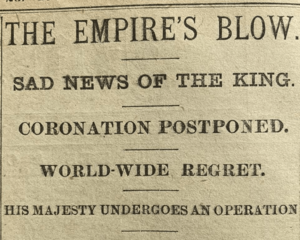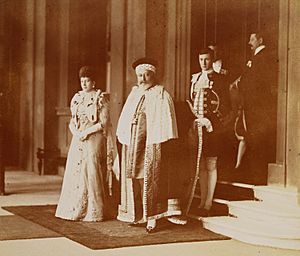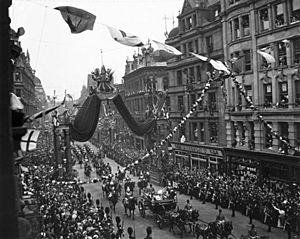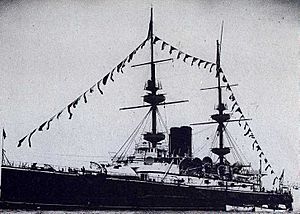Coronation of Edward VII and Alexandra facts for kids

The King and Queen in their coronation robes
|
|
| Date | 9 August 1902 |
|---|---|
| Location | Westminster Abbey, London, England |
| Participants |
|
The coronation of Edward VII and his wife, Alexandra, was a huge event. They became King and Queen of the United Kingdom and its Dominions (countries like Canada and Australia that were part of the British Empire). This special ceremony happened at Westminster Abbey in London on August 9, 1902.
It was first planned for June 26, but had to be delayed at the last minute. King Edward got very sick with a stomach infection that needed surgery right away. Unlike the coronation of Queen Victoria (Edward's mother) 64 years earlier, this one was carefully planned. It was meant to show off the power and culture of the British Empire, which was very strong at the time. It was also a very important religious event.
Contents
Planning the Big Day
The coronation of Queen Victoria in 1838 was a bit messy and not well-rehearsed inside the Abbey. However, the street parades and celebrations across the country were a big hit. After Victoria's Golden and Diamond Jubilee celebrations, people expected Edward's coronation to be just as grand. It was a chance to show the world Britain's status as a major imperial power.
In December 1901, a special committee was set up to plan the event. A key member, Viscount Esher, worked closely with the King. Esher had helped organize the Diamond Jubilee in 1897 and was keen on making royal ceremonies exciting again. Sir Frederick Bridge, the organist at Westminster Abbey, was chosen to lead the music. He was the first Abbey organist since Henry Purcell to have this important role.
The Queen's Special Dress
Lady Curzon, whose husband was the Viceroy of India (a high-ranking official), helped design Queen Alexandra's coronation gown. The Queen asked Lady Curzon for her help in July 1901. Lady Curzon had a lot of freedom with the design. The Queen only asked that the dress include the national flowers of England (the Tudor rose), Scotland (the thistle), and Ireland (the shamrock).
Because the Queen would wear a heavy velvet and ermine cloak, her dress needed to be light. It was made of gold net with shiny metal embroidery called Zari, which Lady Curzon admired from India. It's not fully clear if the dress itself or just the fabric came from India. Work on the Queen's gown started in October 1901 and finished in February 1902. The famous fashion house House of Worth in Paris made the final adjustments.
King Edward's Illness and Delay
By the time he became King, Edward was 59 years old. He was a bit overweight and enjoyed big meals and cigars. He jumped into his new role, but his first few months were full of illnesses and injuries. On June 23, 1902, just three days before the coronation, Edward and Queen Alexandra returned to Buckingham Palace. People noticed he looked "worn and pale" and was leaning heavily on his cane. That evening, they hosted a large dinner for 70 royal guests.
The next day, a telegram was sent across the British Empire. It announced that the coronation was postponed because the King needed an operation. Doctors explained that the King had a serious stomach infection. Sir Frederick Treves performed the surgery right there in Buckingham Palace to drain a cyst.
On June 26, the original coronation day, a special prayer service was held at St Paul's Cathedral. Many important guests who had come for the coronation attended. Even though the wooden stands built for the parade were being taken down, King Edward insisted that other celebrations go ahead. A "Coronation Dinner for the Poor of London" was planned. Sir Sir Thomas Lipton organized 500,000 dinners for Londoners on July 5. The King personally gave £30,000 for the cost.
The delay also led to legal cases, known as the "Coronation cases". Many people had rented rooms along the parade route at high prices. When the coronation was postponed, they wanted their money back. These cases helped set an important rule in English law about contracts that can't be fulfilled. The King also wrote a letter to his people, which was published in newspapers the day before the rescheduled coronation.
The Coronation Ceremony
Because of the delay, many foreign guests did not return for the new date. Their countries were instead represented by their ambassadors. This made the coronation more of a "family celebration" for the British Empire, as one historian noted. About 8,000 guests attended the ceremony at Westminster Abbey. These included prime ministers from British Dominions, rulers from Indian states, and other important leaders.
The Times newspaper proudly wrote that King Edward was the first British King to have leaders from self-governing colonies and Indian princes at his coronation. It showed how united the British Empire was.
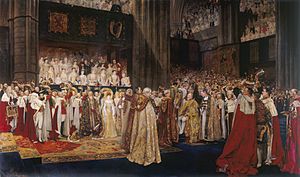
The ceremony itself was carefully planned to be spiritual but also not too long. The main plan was created by Randall Davidson, the Bishop of Winchester.
The service was led by the very old and unwell Archbishop of Canterbury, Frederick Temple. He refused to let anyone else do his duties and had to be supported by two other bishops. Because his eyesight was poor, the service text was printed in huge letters on long rolls of paper. The Archbishop caused a few small problems during the ceremony. He couldn't get up after kneeling and had to be helped by the King and other bishops. He also put the crown on the King's head backward!
The King also did something unexpected. When his son, the Prince of Wales, touched the Crown and kissed his father's cheek (a traditional sign of respect), the King stood up and hugged his son. This was a very unusual public display of affection. Another small moment happened when the King's sister, Princess Beatrice, accidentally dropped her service book from the royal gallery, making a loud noise.
Because he was still recovering, King Edward was crowned with the lighter Imperial State Crown instead of the heavier St Edward's Crown. Queen Alexandra was crowned right after her husband by the Archbishop of York. She wore a new crown that held the famous Koh-i-Noor diamond.
Music for the Coronation
Sir Frederick Bridge was told that the coronation music needed to be grand and majestic. He wanted the music to celebrate four hundred years of English music. So, pieces by old composers like Thomas Tallis and Henry Purcell were played alongside music by newer composers like Arthur Sullivan.
A famous new piece written for the occasion was Hubert Parry's I was glad. This song cleverly included the traditional cheer of "Vivat Rex" (Long Live the King!) by the students of Westminster School as the King entered. This piece has been used in every British coronation since. A French composer, Camille Saint-Saëns, also wrote a piece called Marche du Couronnement. This, along with music by other foreign composers, was played before the King arrived.
The music was performed by a choir of 430 singers, a 65-person orchestra, and 10 State Trumpeters. Frederick Bridge made sure the music was well-coordinated. He had another organist play the organ and used two assistant conductors. The only small mistake was that Bridge finished I Was Glad too early before the King arrived. He had to repeat it when the right moment came, and the organist helped by playing some music in between.
The Grand Procession
The parade was originally supposed to include soldiers from other countries like Germany and Russia. However, after the postponement, these foreign groups went home. This meant the parade became a completely British and Imperial event. Out of 30,000 soldiers marching or lining the route, over 2,000 were from the colonies, Dominions, or the Indian forces. The rest were from every part of the British Army, the Royal Navy, and the Royal Marines.

Carriages carried British and foreign important people. They were followed by the King's personal assistants and famous military leaders like Lord Kitchener.
An estimated one million people watched the procession. It went from Parliament Square through Whitehall to Trafalgar Square, then along Pall Mall, St James's Street and Piccadilly to Hyde Park Corner, and finally down Constitution Hill. When the King and Queen returned to Buckingham Palace, they appeared on the balcony to greet the crowds. This set a new tradition for future coronations.
A second procession, planned for the day after the coronation, was delayed until October 25 due to the King's health. This parade was meant to tour the City of London and Southwark.
The final coronation event was a huge Review of the Fleet on August 16. It took place at Spithead, off the coast of Portsmouth. Without bringing a single warship back from overseas, the Royal Navy gathered an amazing 20 battleships, 24 cruisers, and 47 destroyers. Some foreign warships were also invited to join. About 100,000 people watched from the shore or from boats. Although Queen Victoria had many fleet reviews, this was the first one linked to a coronation.
On the morning of the review, the King met with three Boer commanders (from South Africa) on his royal yacht. This was remarkable because the Second Boer War had only just ended on May 31 that year. The next day, the King was well enough to watch naval exercises at sea.
Images for kids
See Also
- List of British coronations
- The Coronation of Edward VII, a film reenacting the ceremony
- King Edward VII Coronation Medal
- King Edward VII Police Coronation Medal
- Canadian Coronation Contingent
- Hokitika Clock Tower


